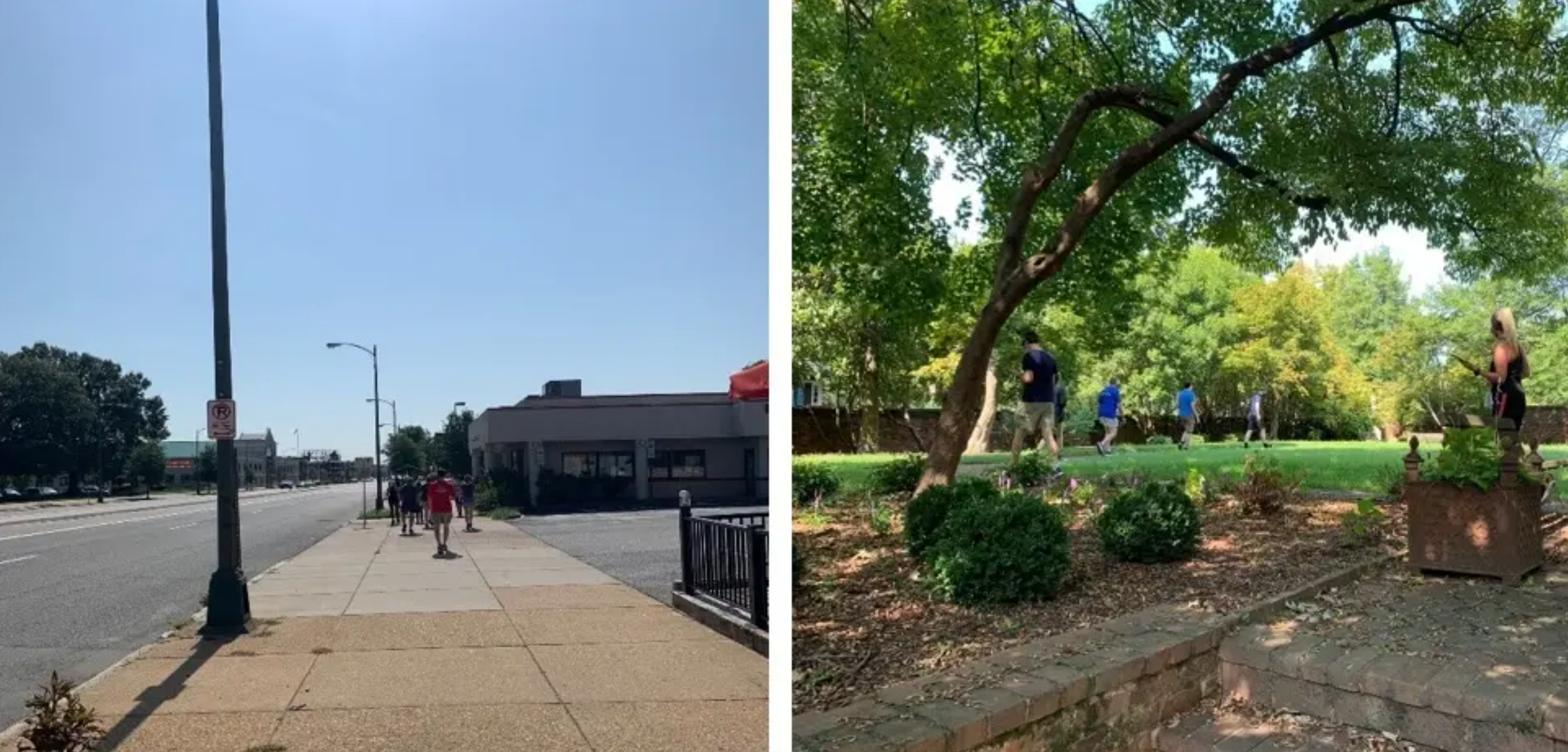News
Walking in urban green spaces is better for us than walking in gray spaces says Wilder School research

by Mary Kate Brogan
Taking a walk is known to reduce stress, but recent research shows that, in cities, where you take that walk matters.
A Richmond-based study led by researchers from the Science Museum of Virginia, Virginia Commonwealth University, University of Virginia and Virginia Tech found that walking in a quiet urban setting with shade and greenery can significantly improve mood and reduce stress, while walking in a noisier urban setting without shade and plants or green space can increase exposure to heat, air pollution and traffic noise — and thus, increase stress levels and heat-related discomfort.
The study, “The Impact of Urban Walking on Psychophysiological Well-Being,” published in Cities & Health this fall, suggests that environment matters when exercising for mental health and supports a growing body of evidence that planning urban environments to incorporate green space can improve residents’ overall health, said study co-author and project co-principal investigator Jeremy S. Hoffman, Ph.D.
“The psychological and physiological benefits to mental health from walking in an urban green setting are likely related to the environmental exposures that individuals experience — namely, noise, temperature and air pollution,” said Hoffman, an affiliate faculty member in the Urban and Regional Studies Program at VCU’s L. Douglas Wilder School for Public and Government Affairs and in VCU’s Center for Environmental Studies. “Given that we’ve tied residential exposure to extreme heat and air pollution to policies like redlining in the past, this research furthers the discussion around equity-centered approaches to alleviating climate-related stressors in Richmond and elsewhere.”
Hoffman, who serves as the David and Jane Cohn Scientist at the Science Museum of Virginia, studies climate change and its impact and was recently a lead co-principal investigator for urban heat island studies in Richmond, Washington, D.C., and Baltimore. Hoffman spoke with VCU News about the findings of this study and how city-dwellers and urban planners can use this knowledge in their daily lives.
Why did you embark on this study, and what did you learn?
How a city or neighborhood is designed can affect our physical well-being in a variety of ways, including our exposures to green space, extreme heat, air pollution and traffic noise. We wanted to know to what extent we could measure these effects right here in Richmond during the early part of the pandemic.
"We basically showed that walking in a shady, quiet neighborhood was like going to a therapist, trainer and outdoor thermal oasis all at the same time. So, we can all work to spend a bit of our time whenever possible enjoying a green space here in the city of Richmond." –Jeremy S. Hoffman
In order to do that, we outfitted a group of Richmond community scientists with air quality, temperature, heart rate and other sensors, asked them some questions about how they felt and had them randomly assigned into groups to take two different walks near the Science Museum of Virginia. One walk took volunteers into The Fan and around The Branch Museum of Architecture and Design's pocket park (the "urban green" walk), while the other took volunteers down and back on Broad Street (the "urban gray" walk). By comparing all of the data collected for each community scientist, we could see how walking in either of these two environments affected several indicators of stress and mood. Applying these findings to how we design public spaces could help improve community well-being in the face of climate change and urban growth.
How does the impact of walking in urban green space differ from walking in other built urban spaces when it comes to people's physiological and psychological (mood/stress) well-being, and why does it matter?
Walking in “urban green” settings like ours has been shown to be extremely important for not only providing a safe place to engage in moderate-intensity activities for health-improving exercise, but also for cognitive health and feelings of depression and anxiety. As only about a third of Richmond's population engages in the Centers for Disease Control and Prevention’s recommended amount of moderate-intensity activity per week and our Community Health Assessment identified elevated levels of mental health issues in Richmond, this research has a real-world, public health implication for our city as it grows.
Based on what you found, what can individuals living in urban environments do in their own lives so that they can better reduce their stress levels and improve their mood?
In our study, we basically showed that walking in a shady, quiet neighborhood was like going to a therapist, trainer and outdoor thermal oasis all at the same time. So, we can all work to spend a bit of our time whenever possible enjoying a green space here in the city of Richmond.
Beyond that, showing our support to prioritize the reallocation of public space to be developed into safe, quiet, shady pedestrian areas for everyone to enjoy, especially in areas of the city that have been denied these resources, could go a long way to achieving our public health, as well as climate change, goals.
How do you hope this project will impact people?
I love how this kind of participatory science can reshape how people see their neighborhood as well as the issues that our city faces. Some residents in Richmond wake up in a hotter neighborhood and have to walk along a shadeless heavy-traffic street to a shadeless bus stop. Knowing that these types of walking environments are detrimental to our physical and mental health should inspire us to make safe access to these kinds of spaces more equitable across our region. It should also inspire us to look at our own front yards and ask: How can I plant more native trees and get cars to slow down and get more people walking in my own neighborhood? We know the answer now from right here in Richmond.
This story originally appeared on VCU News.
